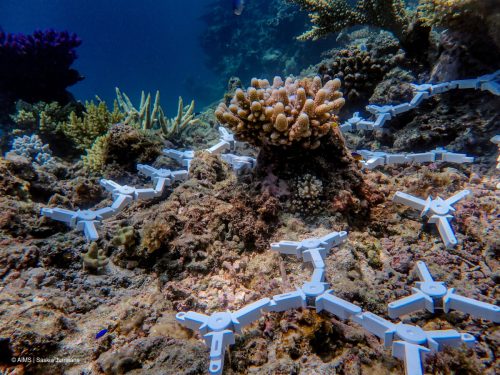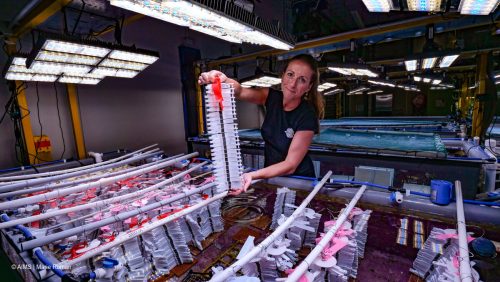
Ceramic coral seeding devices © AIMS | Saskia Jurriaans – corals
What could be the largest coral restoration research trial ever, has been taking place on the Great Barrier Reef. The Australian Institute of Marine Science (AIMS), along with university partners, is working together to give scientists a better understanding of how a combination of techniques can help restore coral reefs at scale.
Breeding, treating and delivering baby corals to the Reef
Various techniques to optimize the environment and health of young corals have been put together to help fast track coral reef recovery after disturbances like coral bleaching. New technologies have made the process more efficient, reduced the reliance on human labor and increased the number of coral larvae produced (they are able to produce 7 million larvae in one night).

Dr Mikaela Nordborg watches over the autospawner – an automated aquaria system designed to produce millions of coral larvae, reducing the need for human involvement. © AIMS | Marie Roman
From aquaculture facilities to the field
Larvae are settled onto special tiles and reared into baby corals over the course of a few weeks. They are then placed onto ceramic devices and delivered to the Reef safely and efficiently.

Greta Zampa holds a tower of coral seeding devices at the National Sea Simulator.© AIMS | Marie Roman
We need to do more than reduce emissions
According to Dr Cedric Robillot of RRAP, warming ocean temperatures cannot just be fought with emission reductions, we need to do more. The field trial is an important step towards “understanding how corals will perform under natural conditions experienced on the Great Barrier Reef now and into the future,” says Dr Line Bay of the Reef Restoration and Adaptation Program (RRAP). The ultimate aim is to deploy millions of heat-tolerant corals on the Reef every year.
To find out more: https://gbrrestoration.org/










0 Comments